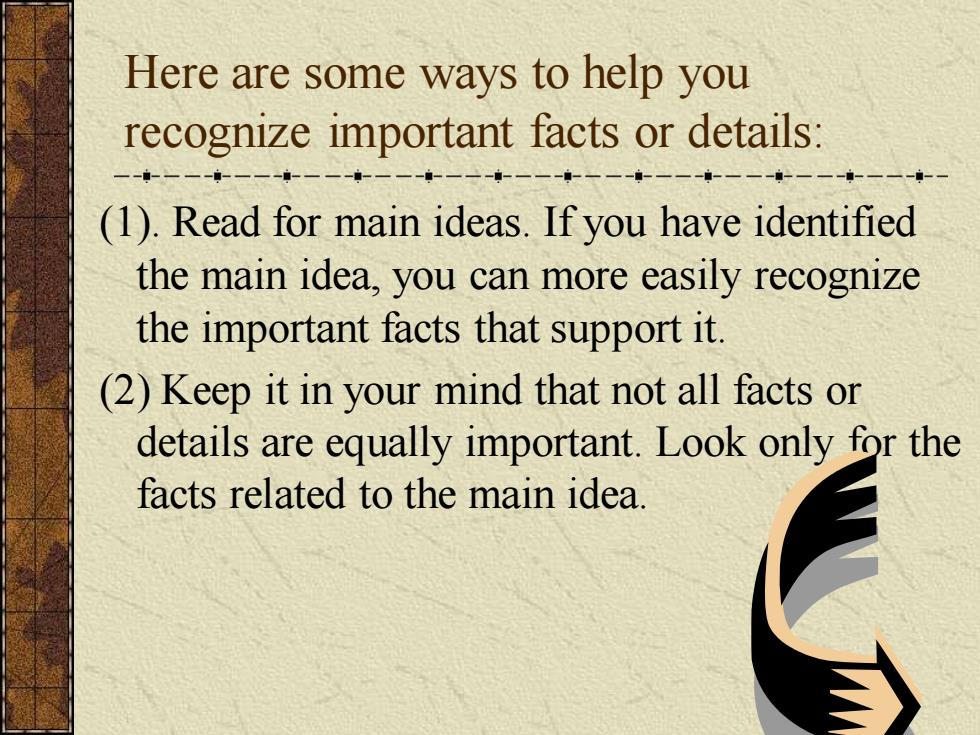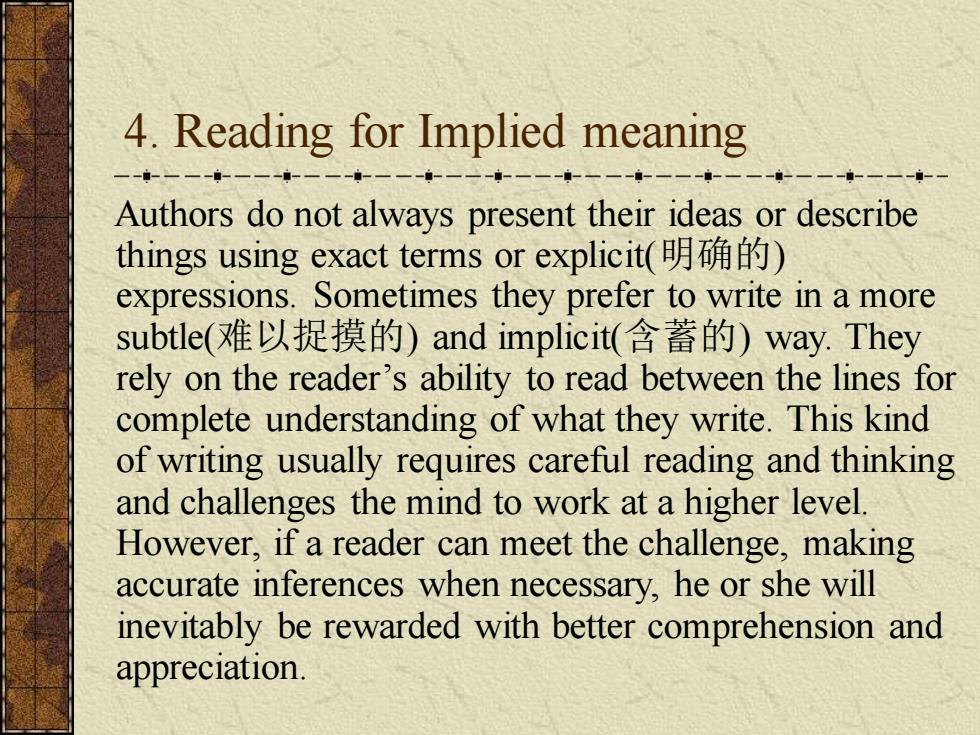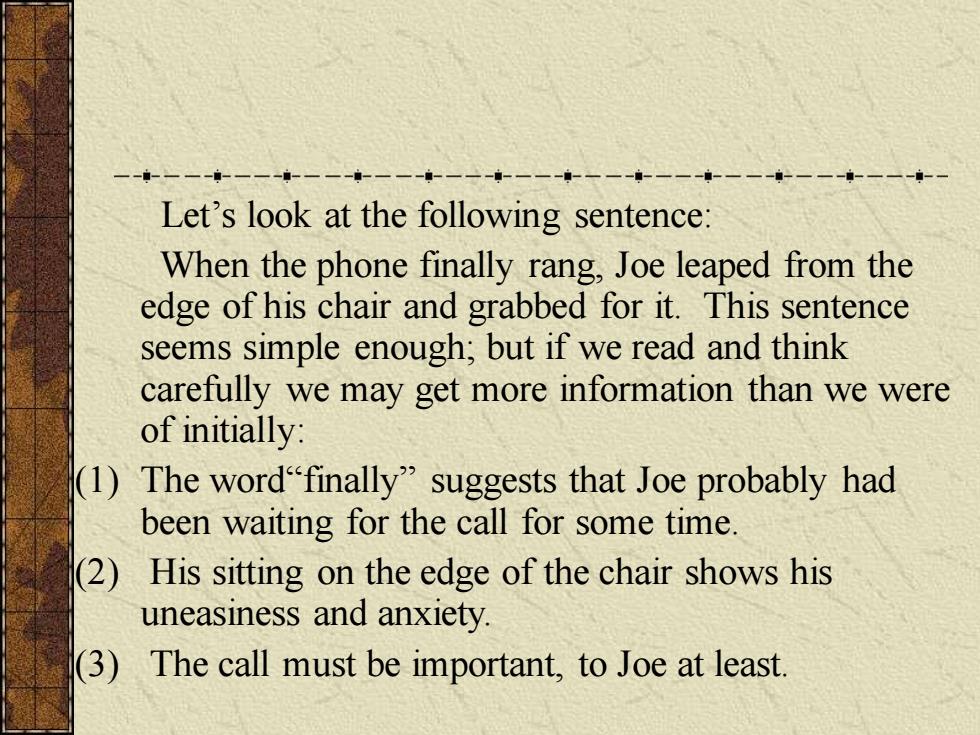
Here are some ways to help you recognize important facts or details: 一■一 (1).Read for main ideas.If you have identified the main idea,you can more easily recognize the important facts that support it. (2)Keep it in your mind that not all facts or details are equally important.Look only for the facts related to the main idea
Here are some ways to help you recognize important facts or details: (1). Read for main ideas. If you have identified the main idea, you can more easily recognize the important facts that support it. (2) Keep it in your mind that not all facts or details are equally important. Look only for the facts related to the main idea

(3)To check on your understanding of the material you have read,review the facts or details which you have decided are the most important.Then consider if they support what you have identified as the main idea.If adding up the facts or details does not lead logically to the main idea,you have failed either to identify the main idea or to recognize the important supporting details
(3)To check on your understanding of the material you have read, review the facts or details which you have decided are the most important. Then consider if they support what you have identified as the main idea. If adding up the facts or details does not lead logically to the main idea, you have failed either to identify the main idea or to recognize the important supporting details

3.Looking for the topic sentence More often than not,one sentence in a paragraph tells the reader exactly what the subject of the paragraph is and thus gives the main idea.This main idea sentence is called a topic sentence or topic statement.The topic sentence states briefly an idea whose full meaning and significance are developed by the supporting details.It may appear at the beginning,or in the middle,or at the end of a paragraph
3. Looking for the topic sentence More often than not, one sentence in a paragraph tells the reader exactly what the subject of the paragraph is and thus gives the main idea. This main idea sentence is called a topic sentence or topic statement. The topic sentence states briefly an idea whose full meaning and significance are developed by the supporting details. It may appear at the beginning, or in the middle, or at the end of a paragraph

4.Reading for Implied meaning Authors do not always present their ideas or describe things using exact terms or explicit(明确的) expressions.Sometimes they prefer to write in a more subtle(难以捉摸的)and implicit(含蓄的)way.They rely on the reader's ability to read between the lines for complete understanding of what they write.This kind of writing usually requires careful reading and thinking and challenges the mind to work at a higher level. However,if a reader can meet the challenge,making accurate inferences when necessary,he or she will inevitably be rewarded with better comprehension and appreciation
4. Reading for Implied meaning Authors do not always present their ideas or describe things using exact terms or explicit(明确的) expressions. Sometimes they prefer to write in a more subtle(难以捉摸的) and implicit(含蓄的) way. They rely on the reader’s ability to read between the lines for complete understanding of what they write. This kind of writing usually requires careful reading and thinking and challenges the mind to work at a higher level. However, if a reader can meet the challenge, making accurate inferences when necessary, he or she will inevitably be rewarded with better comprehension and appreciation

Let's look at the following sentence: When the phone finally rang,Joe leaped from the edge of his chair and grabbed for it.This sentence seems simple enough;but if we read and think carefully we may get more information than we were of initially: (1)The word finally"suggests that Joe probably had been waiting for the call for some time. (2) His sitting on the edge of the chair shows his uneasiness and anxiety. (3) The call must be important,to Joe at least
Let’s look at the following sentence: When the phone finally rang, Joe leaped from the edge of his chair and grabbed for it. This sentence seems simple enough; but if we read and think carefully we may get more information than we were of initially: (1) The word“finally” suggests that Joe probably had been waiting for the call for some time. (2) His sitting on the edge of the chair shows his uneasiness and anxiety. (3) The call must be important, to Joe at least